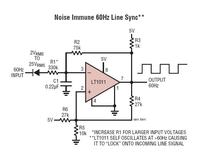Freddybaby
Member level 4
- Joined
- Sep 27, 2007
- Messages
- 70
- Helped
- 3
- Reputation
- 6
- Reaction score
- 1
- Trophy points
- 1,288
- Location
- California, USA
- Activity points
- 1,816
Thinking of using this method to determine phase lag between 2 60Hz sources. I need resolution and decent accuracy to about 8 minutes (0.13 degrees).
My questions are;
Will the crosstalk between amps introduce errors. ?
Do I need to match the forward drops of the input diodes (or use matched sets such as LM394 configured as diode) ?
Can I use input offset correction to trim the delays between ?

My questions are;
Will the crosstalk between amps introduce errors. ?
Do I need to match the forward drops of the input diodes (or use matched sets such as LM394 configured as diode) ?
Can I use input offset correction to trim the delays between ?
